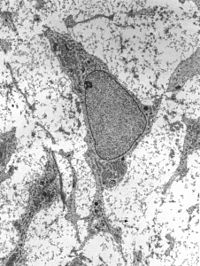
Photo from wikipedia
Cleft lip and palate is the most common congenital anomaly in the orofacial region. Autogenous iliac bone graft, in general, has been employed for closing the bone defect at the… Click to show full abstract
Cleft lip and palate is the most common congenital anomaly in the orofacial region. Autogenous iliac bone graft, in general, has been employed for closing the bone defect at the alveolar cleft. However, such iliac bone graft provides patients with substantial surgical and psychological invasions. Consequently, development of a less invasive method has been highly anticipated. Stem cells from human exfoliated deciduous teeth (SHED) are a major candidate for playing a significant role in tissue engineering and regenerative medicine. The aim of this study was to elucidate the nature of bone regeneration by SHED as compared to that of human dental pulp stem cells (hDPSCs) and bone marrow mesenchymal stem cells (hBMSCs). The stems cells derived from pulp tissues and bone marrow were transplanted with a polylactic-coglycolic acid barrier membrane as a scaffold, for use in bone regeneration in an artificial bone defect of 4 mm in diameter in the calvaria of immunodeficient mice. Three-dimensional analysis using micro CT and histological evaluation were performed. Degree of bone regeneration with SHED relative to the bone defect was almost equivalent to that with hDPSCs and hBMSCs 12 weeks after transplantation. The ratio of new bone formation relative to the pre-created bone defect was not significantly different among groups with SHED, hDPSCs and hBMSCs. In addition, as a result of histological evaluation, SHED produced the largest osteoid and widely distributed collagen fibers compared to hDPSCs and hBMSCs groups. Thus, SHED transplantation exerted bone regeneration ability sufficient for the repair of bone defect. The present study has demonstrated that SHED is one of the best candidate as a cell source for the reconstruction of alveolar cleft due to the bone regeneration ability with less surgical invasion.
Journal Title: Biochemical and biophysical research communications
Year Published: 2018
Link to full text (if available)
Share on Social Media: Sign Up to like & get
recommendations!